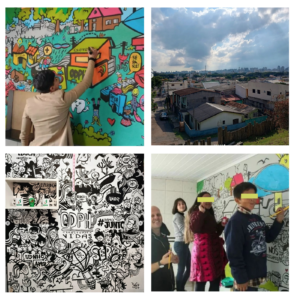News . Best Practices Visual thinking and illustrated mind maps as tools for visualizing the profile of a vulnerable Community.

This Best Practices report an open schooling initiative called CONNECT PUCPR, which was developed by Professor Rafael Camargo in collaboration with the NGO ODPH – Organização para o Desenvolvimento do Potencial Humano, from March 3rd to June 28th, 2022. The activities included a professional in art education and scientific research. This initiative was supported by the Pontifical Catholic University of Paraná. More information about this practice was previously presented here:
Care: Students were engaged with the possibility of using drawing and art to visualize real-life problems and discuss the best places to play in and explore their local environment. The 20 students who participated in the activities were between the ages of 10 and 14 and attended local public schools in the morning, while studying at the NGO during the afternoon.
Know: The students used their knowledge of visual thinking exercises, perspective, character development and model sheets, 3D and volumetry aspects, coloring, discussion, and collaboration to develop a collective mural of art and storytelling, exploring the historical local problem of a polluted river.
Do: At the end of the initiative, the students prepared Illustrated Mind Maps to record points of personal interest and created two Art Murals to express and share their ideas. One of the murals registered their “vision” and dreams, while the other one visualized data/actions and places in the city and community. We believe that science and scientific problems should be integrated and visualized with easy comprehension for vulnerable persons living in complex scenarios. The activities were completed in groups with support from three professors and an employee from the cleaning department.
Findings related to the Open Schooling approach: This activity was not part of the curriculum, but it was so relevant in integrating university students and professors with vulnerable communities, with a focus on visualizing a problem and sharing a vision of the future. Open schooling might be helpful for other teachers because it can provide a collaborative, not expensive, and co-creative process to facilitate explaining complex content for vulnerable communities, visualizing data, drawing projects, registering a system of ideas, and sensitizing persons to become changemakers.
Students’ outcomes: The students were involved in art and Paulo Freire’s cultural cycle, discussions to discover local themes, and enjoyed the process. After three weeks, I observed that they were more self-confident in the process, with me as a “researcher,” and with our common purpose. For example, a student mentioned the very hard moments that they lived with their families and local crimes, as well as the difficulty of playing or even being close to the river because it was always dirty and polluted, and there were not many good places to play near the school/NGO. I believe that this gathering of feelings and opinions, especially from children living in vulnerable scenarios, is an opportunity to listen to real problems and integrate the university into society. Therefore, the outcome is deeper than just the method or even this lived experience. For the students, this constant exchange can amplify their vision of the world and provide possibilities to change difficulties.